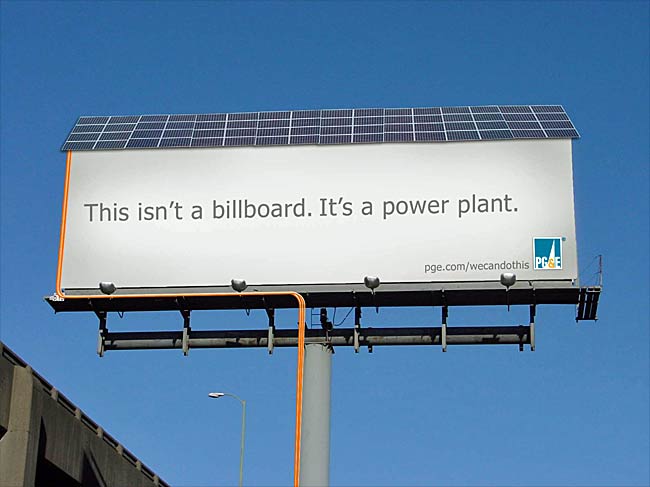Solar Billboard Billed as a Power Plant

Energy-sapping billboards, your days may be numbered. A California electricity supplier says it has installed the nation's first solar-powered billboard, which generates more electricity than it uses.
The billboard—roofed with 20 solar panels—is located at 1000 Brannan St. in San Francisco, and is visible from the Highway 101 9th Street exit.
"The energy that is collected by the solar panels actually exceeds the amount used by it on a day-to-day basis," said Pacific Gas and Electric (PG&E) spokesperson Jennifer Zelwer of the standard-sized billboard, which proclaims: "This isn't a billboard. It's a power plant."
On sunny days, the sign converts sunlight into about 3.4 kilowatts of energy, which is almost enough to power the household of an average U.S. family of four during the day. Zelwer said the billboard generates about 2.5 kilowatts of energy during cloudy days.
Although the billboard does borrow electricity at night, she said it has other green-technology tricks up its sleeves to keep the ratio of energy produced to energy consumed in the positive.
"We installed [light-emitting diode] lights on it, so it uses less than a third of the energy [that] billboards with halophane lights do," she told LiveScience.
PG&E's new solar-powered billboard isn't the first in the world, as both Canada and Africa already have them. But Zelwer said it is the first in the Americas to actually push power onto an electrical grid, like ones in Africa do.
Get the world’s most fascinating discoveries delivered straight to your inbox.
Zelwer cautioned that solar-powered placard is only for show at this time, but said she would eventually like to see similar ones replacing standard billboards up and down highways. "If these are going to be en masse in the future, that certainly would be a wonderful thing," she said.
Adam Browning, executive director of the nonprofit group Vote Solar Initiative, agrees.
"Solar power is a core element in California's response to meeting increased electric demand and reducing greenhouse gas emissions," Browning said. "PG&E has demonstrated a commitment to making renewable energy work for California. This leadership is critical if we are to be successful in fighting global warming."
- Top 10 Emerging Environmental Technologies
- Power of the Future: 10 Ways to Run the 21st Century
- Quiz: What's Your Environmental Footprint?


